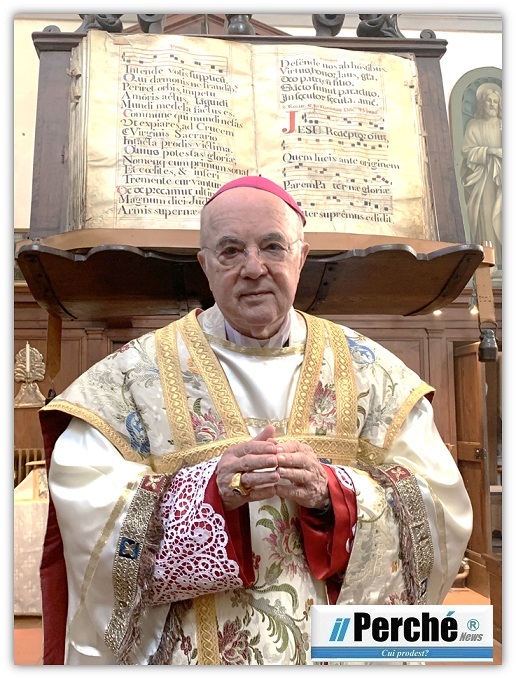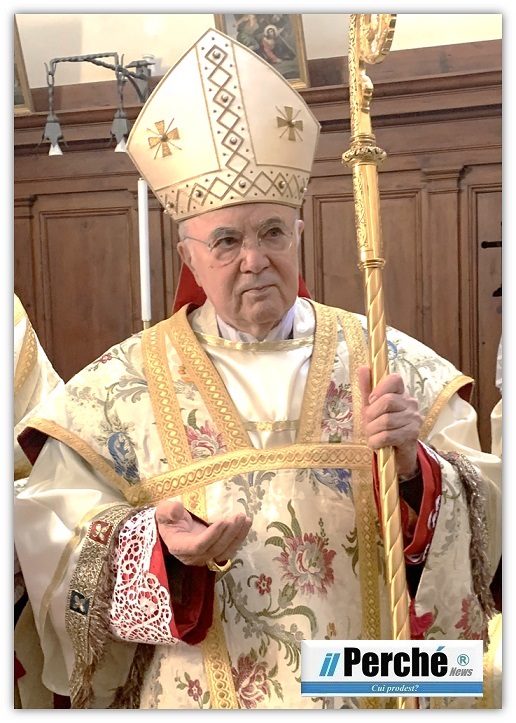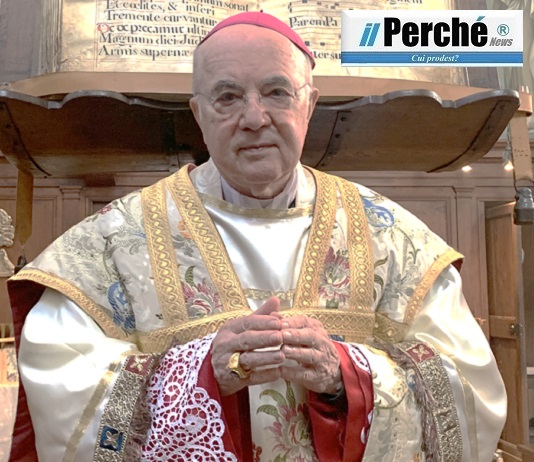Breve riflessione sul sondaggio di Real Presence Coalition per LifeSite News dell’Arcivescovo Mons. Carlo Maria Viganò già Nunzio Apostolico negli Usa

Potrebbe commentare i risultati del più grande sondaggio condotto tra i Cattolici negli Stati Uniti, secondo il quale la ragione numero 1 per la perdita della fede nella vera presenza di Cristo nell’Eucaristia è la comunione nella mano?
Il sondaggio condotto dalla Real Presence Coalition conferma ciò che era già evidente sin da quando Paolo VI autorizzò la modifica della disciplina in materia. Anzitutto, era chiaro che le cosiddette “riforme” imposte da una cupola di Modernisti eversori non rispondevano ad alcuna richiesta “della base”. Né il Novus Ordo, né le nuove modalità di amministrazione della Comunione erano il frutto di un reale bisogno del corpo ecclesiale. È vero invece il contrario, e cioè che la cosiddetta riforma liturgica doveva aiutare a diffondere tra il Clero e i fedeli la dottrina che essa racchiudeva, facendo sì che la πρᾶξις influisse sulla δόξα. Il concetto riassunto dall’adagio Lex orandi, lex credendi è stato adottato ampiamente dai fautori della riforma conciliare, ma al contrario e dolosamente: in questo caso non è infatti l’oρθοδοξία che determina la ὀρθοπραξία, ma la ἑτεροπραξία che plasma la ἑτεροδοξία.
Il fedele a cui è chiesto di inginocchiarsi per ricevere in bocca la Santa Comunione è portato dai gesti che compie a riconoscere nelle Sacre Specie la Presenza Reale e ad aderire alla dottrina cattolica relativa. Analogamente il fedele a cui è chiesto di non inginocchiarsi e di toccare la particola con le mani finisce col credere alla dottrina eterodossa insinuata dai riti riformati. Questo cambiamento dottrinale è ulteriormente favorito nel momento in cui il cambiamento rituale sostituisce una prassi del tutto opposta.
Ciò dimostra inequivocabilmente che coloro che hanno messo mano alla Liturgia dopo il Concilio sapevano benissimo quale sarebbe stata la portata dirompente del Novus Ordo nel corrompere la Fede del popolo di Dio. Essi non hanno modificato esplicitamente la lex credendi, ma hanno voluto esprimere le loro deviazioni nella lex orandi, ben sapendo che sarebbe stato molto più semplice far perdere la fede nella Presenza Reale facendo ricevere la Comunione in piedi e in mano, piuttosto di predicare dai pulpiti questi errori continuando ad amministrare la Comunione in ginocchio e in bocca. Il fatto che la Gerarchia abbia imposto ai fedeli la Comunione in piedi e in mano è stato recepito come una sconfessione del passato e un rigetto della dottrina precedente.
L’evidenza di questo ragionamento è confermata da una fonte insolita: ChatGPT, un’app di “intelligenza artificiale” conversazionale. Ho provato ad interrogare ChatGTP non perché la consideri una forma vera di intelligenza ma perché il suo sistema di elaborazione dei dati individua rapporti di causalità sul modello matematico ed è quindi interessante vedere come un algoritmo sia in grado di rilevare ciò che la narrazione mainstream finge di non vedere.
Questa la domanda che ho fatto:
Se un Papa volesse indebolire la fede dei Cattolici nella Presenza Reale, come dovrebbe modificare il rito della Comunione?
Questa la risposta che ho avuto:
Se un Papa volesse indebolire la fede cattolica nella Presenza Reale, potrebbe considerare alcune modifiche al rito della Comunione, come:
- Rituali semplificati: Ridurre il numero di elementi rituali che sottolineano la sacralità della Comunione, come l’adorazione o la genuflessione.
- Elementi simbolici: Promuovere un’enfasi sulla simbologia del pane e del vino, piuttosto che sulla loro trasformazione nel Corpo e nel Sangue di Cristo.
- Comunicazione verbale: Utilizzare un linguaggio che evidenzi la Comunione come un atto commemorativo piuttosto che un incontro reale con Cristo.
- Modifica delle preghiere: Cambiare le preghiere e i testi liturgici per riflettere una visione più simbolica della Comunione, minimizzando riferimenti alla Presenza Reale.
- Flessibilità nell’amministrazione: Consentire forme alternative di ricezione della Comunione che possano sembrare meno sacramentali, come riceverla in forma più informale o senza celebrazione liturgica.
Questi cambiamenti potrebbero contribuire a una visione più attenuata della Presenza Reale tra i fedeli.
Sappiamo benissimo che la cosiddetta “intelligenza artificiale” altro non è se non un sistema informatico molto veloce per la raccolta e l’analisi di una mole enorme di dati. Ma proprio per questo possiamo comprendere come una macchina senza coscienza sappia rispondere chiaramente a un quesito, svelando la premeditazione e il dolo di chi ha manomesso la Liturgia della Chiesa per manomettere la sua Fede.
Dinanzi all’evidenza degli intenti eversivi della rivoluzione conciliare e all’ancor più evidente disastro che essa ha provocato nei fedeli e in tutto il corpo ecclesiale, è indispensabile opporre un’azione contraria, la quale deve necessariamente consistere, da una parte, nel rifiuto sine glossa del Novus Ordo e dell’impianto dottrinale ed ecclesiologico che esso sottende; e dall’altra, nel pieno ritorno al Rito Apostolico Tradizionale, che per stessa ammissione dei fautori del Vaticano II è incompatibile con la loro “chiesa”. Questa restaurazione liturgica non può e non deve essere motivata da mere preferenze estetiche o di gusto, bensì dalla consapevolezza che l’unica lex orandi della Chiesa Cattolica è quella sancita da duemila anni di ininterrotta e integrale professione della stessa Fede, e non il frutto di un bricolage ereticale raffazzonato da massoni e protestanti.
+ Carlo Maria Viganò, Arcivescovo
30 Ottobre 2024

Versione in lingua inglese:

Brief Reflection on the Survey Conducted by the Real Presence Coalition for LifeSite News
Could you comment on the findings of the largest survey of Catholics in the United States which found that the #1 reason for loss of faith in the Real Presence of Christ in the Eucharist is communion in the hand?
The poll conducted by the Real Presence Coalition confirms what was already evident when Paul VI authorized the modification of the discipline in this matter. First of all, it was clear that the so-called “reforms” imposed by a group of subversives Modernists did not respond to any request “from the grass roots.” Neither the Novus Ordo nor the new ways of administering Communion were the fruit of a real need of the ecclesial body. The opposite is true, however, that the so-called liturgical reform was intended to help spread the doctrine it contained among the clergy and the faithful, causing the πρᾶξις to influence the δόξα. The concept summarized by the adage Lex orandi, lex credendi has been widely adopted by the proponents of the conciliar reform, but in reverse and maliciously: in this case it is not in fact the oρθοδοξία that determines the ὀρθοπραξία, but the ἑτεροπραξία that shapes the ἑτεροδοξία.
The faithful who are asked to kneel to receive Holy Communion in the mouth are led by the gestures they make to recognize the Real Presence in the Sacred Species and to adhere to the corresponding Catholic doctrine. Similarly, the faithful who are asked not to kneel and to touch the Host with their hands end up believing the heterodox doctrine insinuated by the Reformed rites. This doctrinal change is further favored when the ritual change replaces an entirely opposite practice.
This shows unequivocally that those who meddled with the Liturgy after the Council knew very well what would be the disruptive scope of the Novus Ordo in corrupting the Faith of the people of God. They did not explicitly modify the lex credendi, but wanted to express their deviations in the lex orandi, knowing full well that it would have been much easier to make people lose faith in the Real Presence by making them receive Communion standing and in their hands, rather than preaching these errors from the pulpits while continuing to administer Communion on their knees and in the mouth. The fact that the Hierarchy has imposed standing and holding Communion on the faithful has been perceived as a repudiation of the past and a rejection of previous doctrine.
The evidence for this reasoning is confirmed by an unusual source: ChatGPT, a conversational “artificial intelligence” app. I tried to interrogate ChatGTP not because I consider it a true form of intelligence but because its data processing system identifies causal relationships on the mathematical model and it is therefore interesting to see how an algorithm is able to detect what the mainstream narrative pretends not to see.
This is the question I asked:
If a Pope wanted to weaken the faith of Catholics in the Real Presence, how should he modify the rite of Communion?
This is the answer I got:
If a Pope wanted to weaken the Catholic faith in the Real Presence, he might consider some changes to the rite of Communion, such as:
- Simplified rituals: Reduce the number of ritual elements that emphasize the sacredness of Communion, such as worship or genuflection.
- Symbolic elements: Promote an emphasis on the symbolism of the bread and wine, rather than on their transformation into the Body and Blood of Christ.
- Verbal communication: Use language that highlights Communion as a commemorative act rather than an actual encounter with Christ.
- Modification of prayers: Change prayers and liturgical texts to reflect a more symbolic vision of Communion, minimizing references to the Real Presence.
- Flexibility in administration: Allow alternative forms of receiving Communion that may seem less sacramental, such as receiving it in a more informal form or without liturgical celebration.
These changes could contribute to a more muted view of the Real Presence among the faithful.
We know very well that so-called “artificial intelligence” is nothing more than a very fast computer system for the collection and analysis of a huge amount of data; but precisely for this reason we can understand how a machine without conscience knows how to answer a question clearly, revealing the premeditation and malice of those who have tampered with the Liturgy of the Church in order to tamper with the Church’s Faith.
In the face of the evidence of the subversive intentions of the conciliar revolution and the even more evident disaster that it has caused in the faithful and in the entire ecclesial body, it is indispensable to oppose a contrary action, which must necessarily consist, on the one hand, in the sine glossa rejectionof the Novus Ordo and of the doctrinal and ecclesiological structure that underlies it; and on the other hand, in a full return to the traditional Apostolic Rite, which by the very admission of the proponents of Vatican II is incompatible with their “church.” This liturgical restoration cannot and must not be motivated by mere aesthetic or taste preferences, but by the awareness that the only lex orandi of the Catholic Church is the one sanctioned by two thousand years of uninterrupted and integral profession of the same Faith, and not the fruit of a heretical bricolage cobbled together by Freemasons and Protestants.
+ Carlo Maria Viganò, Archbishop
October 30, 2024

Versione in lingua francese:

Brève réflexion sur le sondage par Real Presence Coalition pour LifeSite News
Pourriez-vous commenter les résultats de la plus grande enquête menée auprès des Catholiques aux États-Unis qui a révélé que la première raison de la perte de foi en la Présence réelle du Christ dans l’Eucharistie est la communion dans la main ?
L’enquête menée par la Real Presence Coalition confirme ce qui était déjà évident depuis que Paul VI a autorisé le changement de discipline en la matière. Tout d’abord, il est clair que les prétendues « réformes » imposées par une crique de Modernistes subversifs ne répondaient à aucune demande « de la base ». Ni le Novus Ordo, ni les nouvelles modalités d’administration de la Communion n’ont été le fruit d’un besoin réel du corps ecclésial. Au contraire, la soi-disant réforme liturgique devait contribuer à diffuser parmi le Clergé et les fidèles la doctrine qu’elle contenait, en faisant en sorte que la πρᾶξις influence la δόξα. Le concept résumé par l’adage Lex orandi, lex credendi a été largement repris par les partisans de la réforme conciliaire, mais à l’envers et avec malice : en l’occurrence, ce n’est en effet pas l’oρθοδοξία qui détermine l’ὀρθοπραξία, mais l’ἑτεροπραξία qui façonne l’ἑτεροδοξία.
Les fidèles à qui l’on demande de s’agenouiller pour recevoir la Sainte Communion dans la bouche sont amenés, par les gestes qu’ils posent, à reconnaître dans les Saintes Espèces la Présence Réelle et à adhérer à la doctrine catholique correspondante. De même, les fidèles à qui l’on demande de ne pas s’agenouiller et de toucher la particule avec leurs mains finissent par croire à la doctrine hétérodoxe impliquée par les rites réformés. Ce changement doctrinal est d’autant plus encouragé que le changement rituel remplace une pratique totalement opposée.
Cela démontre sans équivoque que ceux qui ont mis la main sur la liturgie après le Concile savaient parfaitement quelle serait la portée perturbatrice et bouleversante du Novus Ordo pour corrompre la Foi du peuple de Dieu. Ils n’ont pas explicitement changé la lex credendi, mais ils ont voulu exprimer leurs déviations dans la lex orandi, sachant très bien qu’il serait beaucoup plus facile de faire perdre la foi en la Présence Réelle en faisant recevoir aux fidèles la Communion debout et dans leurs mains, que de prêcher en chaire ces erreurs en continuant à administrer la Communion à genoux et dans la bouche. Le fait que la Hiérarchie ait forcé les fidèles à recevoir la Communion debout et dans la main a été perçu comme un désaveu du passé et un rejet de la doctrine antérieure.
La preuve de ce raisonnement est confirmée par une source inhabituelle : ChatGPT, une application conversationnelle d’« intelligence artificielle ». J’ai essayé d’interroger ChatGTP non pas parce que je la considère comme une véritable forme d’intelligence, mais parce que son système de traitement des données détecte les relations causales sur le modèle mathématique et qu’il est donc intéressant de voir comment un algorithme est capable de détecter ce que le récit dominant fait semblant de ne pas voir.
Voici la question que j’ai posée :
Si un pape voulait affaiblir la foi des Catholiques en la Présence Réelle, comment devrait-il changer le rite de la Communion ?
Voici la réponse que j’ai obtenue :
Si un pape voulait affaiblir la croyance catholique en la Présence Réelle, il pourrait envisager des changements dans le rite de la Communion, comme par exemple :
1. Des rituels simplifiés : Réduire le nombre d’éléments rituels qui soulignent le caractère sacré de la Communion, tels que l’adoration ou la génuflexion.
2. Éléments symboliques : mettre l’accent sur le symbolisme du pain et du vin, plutôt que sur leur transformation en Corps et Sang du Christ.
3. Communication verbale : utiliser un langage qui met l’accent sur la Communion en tant qu’acte commémoratif plutôt que sur la rencontre réelle avec le Christ.
4. Modification des prières : modifier les prières et les textes liturgiques pour refléter une vision plus symbolique de la Communion, en minimisant les références à la Présence Réelle.
5. Flexibilité dans l’administration : autoriser d’autres formes de réception de la communion qui peuvent sembler moins sacramentelles, comme la recevoir de manière plus informelle ou sans célébration liturgique.
Ces changements pourraient contribuer à une vision plus atténuée de la Présence Réelle parmi les fidèles.
Nous savons très bien que la soi-disant « intelligence artificielle » n’est rien d’autre qu’un système informatique très rapide pour la collecte et l’analyse d’une énorme quantité de données. Mais précisément à cause de cela, nous pouvons comprendre comment une machine sans conscience peut répondre clairement à une question, révélant la préméditation et la malice de ceux qui ont altéré la Liturgie de l’Église pour altérer sa Foi.
Face à l’évidence des intentions subversives de la révolution conciliaire et au désastre encore plus évident qu’elle a provoqué chez les fidèles et dans le corps ecclésial tout entier, il est indispensable d’opposer une action contraire, qui doit nécessairement consister, d’une part, dans le rejet sine glossa du Novus Ordo et de la structure doctrinale et ecclésiologique qu’il sous-tend, et, d’autre part, dans le retour intégral au Rite Apostolique Traditionnel, qui, de l’aveu même des partisans de Vatican II, est incompatible avec leur « église ». Cette restauration liturgique ne peut et ne doit pas être motivée par de simples préférences esthétiques ou par le goût, mais plutôt par la conscience que l’unique lex orandi de l’Église Catholique est celle établie par deux mille ans de profession ininterrompue et intégrale de la même Foi, et non le fruit d’un bricolage hérétique concocté par les francs-maçons et les protestants.
+ Carlo Maria Viganò, Archevêque
30 Octobre 2024
Ricevuto e pubblicato il 01 Novembre 2024



